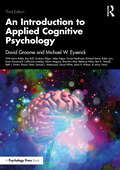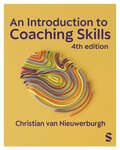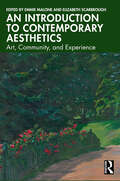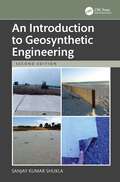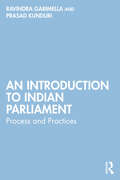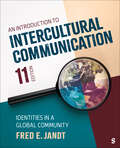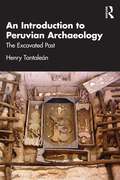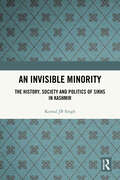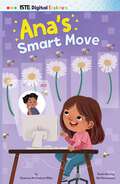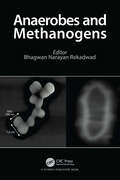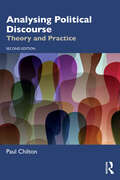- Table View
- List View
An Introduction to Applied Cognitive Psychology
by David Groome Michael EysenckThis bestselling textbook offers an accessible introduction to the application of cognitive psychology, looking at how the findings of cognitive psychologists have been put to use in real life.Using real-world scenarios and engaging everyday examples, the book offers clear explanations of how cognitive psychology can be applied in the real world, as well as the different methods, theories and models of research employed. It explores all of the major areas of cognitive psychology, including attention, perception, memory, thinking and decision making, as well as some of the factors that affect cognitive processes, such as drugs and biological cycles. The third edition has been thoroughly updated to include new material on working memory training and prospective cognition.Written by well-respected experts in the field, this textbook will appeal to all undergraduate students of cognitive psychology, as well as students of applied and forensic psychology.
An Introduction to Child and Adolescent Mental Health
by Maddie Burton Clive SealeyAre you looking to develop your expertise in child and adolescent mental health? This comprehensive guide is updated to help you: 1) understand the current social, political and ideological contexts of child and adolescent mental health 2) develop an understanding of child and adolescent development and mental health conditions 3) identify appropriate mental health promotion strategies and mental health interventions for working with children and adolescents 4) assess appropriate group work and communication strategies for improving the mental health of children and adolescents 5) improve knowledge and practice of child and adolescent safeguarding, rights and culture Written by a multi-disciplinary team of passionate experts, this book introduces important theories while showing how they can be applied to real world practice. Packed with examples and activities to get you thinking and learning, it is an essential introduction for anyone interested in or working to improve child and adolescent mental health.
An Introduction to Child and Adolescent Mental Health
by Maddie Burton Clive SealeyAre you looking to develop your expertise in child and adolescent mental health? This comprehensive guide is updated to help you: 1) understand the current social, political and ideological contexts of child and adolescent mental health 2) develop an understanding of child and adolescent development and mental health conditions 3) identify appropriate mental health promotion strategies and mental health interventions for working with children and adolescents 4) assess appropriate group work and communication strategies for improving the mental health of children and adolescents 5) improve knowledge and practice of child and adolescent safeguarding, rights and culture Written by a multi-disciplinary team of passionate experts, this book introduces important theories while showing how they can be applied to real world practice. Packed with examples and activities to get you thinking and learning, it is an essential introduction for anyone interested in or working to improve child and adolescent mental health.
An Introduction to Coaching Skills: A Practical Guide
by Christian van NieuwerburghThis bestselling book introduces you step-by-step to the key skills needed to become a successful coach. Focusing on the main coaching skills of listening, asking powerful questions, playing back and noticing, this practical book supports you to become more self-aware and confident as you support others to learn, grow and develop. Supported by a suite of video examples and practical activities, this book is an invaluable companion for novices and trainee coaches. Now in its fourth edition, this book is more aligned to the competencies of the leading professional associations of coaching and has been revised and updated to take into account developments in the field. New to Fourth Edition: New learning features, including "What the professional associations say", "Reflect on your practice", and "A question for you" New suite of 30 online video examples displaying a range of key coaching skills in action New chapter on "coaching in context" on the implications of coaching in different contexts, such as education and health settings Increased focus on online coaching
An Introduction to Coaching Skills: A Practical Guide
by Christian van NieuwerburghThis bestselling book introduces you step-by-step to the key skills needed to become a successful coach. Focusing on the main coaching skills of listening, asking powerful questions, playing back and noticing, this practical book supports you to become more self-aware and confident as you support others to learn, grow and develop. Supported by a suite of video examples and practical activities, this book is an invaluable companion for novices and trainee coaches. Now in its fourth edition, this book is more aligned to the competencies of the leading professional associations of coaching and has been revised and updated to take into account developments in the field. New to Fourth Edition: New learning features, including "What the professional associations say", "Reflect on your practice", and "A question for you" New suite of 30 online video examples displaying a range of key coaching skills in action New chapter on "coaching in context" on the implications of coaching in different contexts, such as education and health settings Increased focus on online coaching
An Introduction to Contemporary Aesthetics: Art, Community, and Experience
by Emmie Malone Elizabeth ScarbroughAn Introduction to Contemporary Aesthetics: Art, Community, and Experience gives students and other readers a comprehensive sense of the dynamic issues and problems in aesthetics and philosophy of art today. Each of the 14 chapters is written by a different expert in the field, and together they cover a wide range of methodological approaches and perspectives, including those from analytic and Continental philosophy, non-Eurocentric global traditions, and critical stances taken up by feminist philosophers and philosophers of race. In addition, the volume makes use of recent empirical work on art and beauty as well as examples of artistic expressions from cultures from around the world. In contrast to other coursebooks, which are often structured entirely around artforms, this volume frames much of its contents around core aesthetic concepts—like good or bad taste, interpretation, or authenticity—with each chapter devoted to a different concept. Within each chapter, the reader will find a range of engaging artforms and experiences. The contents of the volume are laid out in four parts: the first focuses on foundational questions in aesthetics and the second on key aesthetic concepts. The third part focuses on applied questions relating to particular artforms and genres (e.g., horror, comedy, AI art, games). Finally, the last part of the volume takes a wider, but still practical, view, focusing on why aesthetic life matters to us, both as a society and as individuals.Key Features Written in a non-technical style for readers new to aesthetics and with little or no background in philosophy or the study of the arts Draws on examples readers encounter in everyday life and popular culture, from Drake to Philly cheesesteaks Deals with questions that concern many college students today: Does authenticity even matter and, if so, why? What’s wrong with enjoying the work of an immoral artist? How are our homes and schools important places of aesthetic meaning? Each chapter is written as a biased survey, with clear coverage of the historical and contemporary literature on the topic but also from a distinct, subjective point of view Non-Eurocentric philosophies or examples are included throughout the book, highlighting the rich and diverse philosophical work from around the globe Discussion Questions offer student readers opportunities to engage more fully with the problems raised in the text Suggestions for Further Reading at the end of each chapter identify the most promising avenues for further research on the topic
An Introduction to Design and Culture: 1900 to the Present
by Penny SparkeAn Introduction to Design and Culture provides a comprehensive guide to the changing relationships between design and culture from 1900 to the present day with an emphasis on five main themes:• Design and consumption• Design and technology• The design profession• Design theory• Design and identities.This fifth edition extends the traditional definition of design to embrace its more recent manifestations, which include service design, user-interface design, co-design, and sustainable design. It also discusses the relationship between design and the new media and the effect of globalisation and transnationalism on design. Most importantly, it looks at its contents through a new lens which acknowledges the post-industrial, post-colonial, post-modern, (and, arguably, post-design) climate of the twenty-first century and the challenges that it poses.Taking a broadly chronological approach, Professor Sparke employs historical methods to show how these themes developed through the twentieth century and into the twenty-first century and played a role within modernism, post-modernism and beyond. Over a hundred illustrations are used throughout to demonstrate the breadth of design, and examples – among them design in Modern China, the work of Apple Computers Ltd., and design thinking – are used to elaborate key ideas. The new edition remains essential reading for undergraduate and postgraduate students of design studies, cultural studies and visual arts.
An Introduction to Fairbairn's Psychology of Dynamic Structure: The Analysis of Cultural Objects
by Graham S ClarkeAn Introduction to Fairbairn's Psychology of Dynamic Structure: The Analysis of Cultural Objects describes W. R. D. Fairbairn's model of endopsychic structure and includes his thoughts on the social and the aesthetic. It offers a modified version of Fairbairn's model based upon his thinking about the moral defence, psychic growth, and mature dependence. The model is brought to life by its application to the analysis of a number of cultural objects: Bronzino's An Allegory of Venus and Cupid, Dennis Potter's trailblazing miniseries The Singing Detective, the enchanting anime Spirited Away directed by Hayao Miyazaki, and the mind-bending cinematic experience that is Everything Everywhere All at Once. Author Graham S. Clarke also considers the current conditions affecting psychoanalysis and psychoanalytic theories: a society with increasing opposition to depth thinking of any sort and the rise of populism and the neoliberal notion of the 'self as entrepreneur'. He offers suggestions as to how these trends might be understood and challenged. In particular, he describes how Fairbairn's theory might be considered as, and provide a basis for, a critical realist personal relations approach to psychoanalysis. This book is ideal reading for all psychoanalysts and those interested in the cultural impact of the arts.
An Introduction to Geosynthetic Engineering
by Sanjay Kumar ShuklaGeosynthetics, primarily made from synthetic polymers, provide efficient, cost-effective, and sustainable solutions for civil, geotechnical, and environmental challenges. Enhancing infrastructure performance with soil and rock, they are integral to global construction standards. Beyond civil engineering, their applications extend to mining, agriculture, and aquaculture. This book explores the principles, properties, and applications of geosynthetics, offering tailored solutions for innovative and sustainable infrastructure development.This updated second edition of An Introduction to Geosynthetic Engineering provides a comprehensive introduction to geosynthetics, meeting the needs of senior undergraduate and postgraduate students, practising engineers, and professionals. It includes expanded content, updated chapters, new sections, detailed site photographs, revised standards and guidelines, additional examples, and practice questions. Tailored to support both learning and practical application, this textbook is an essential resource for understanding and utilizing geosynthetics in sustainable infrastructure development.
An Introduction to Indian Parliament: Process and Practices
by Ravindra Garimella Prasad KunduriThis book presents a comprehensive introduction to Indian Parliament encapsulating the process and practices since its inception. It discusses crucial themes including the emergence of Parliament and its contours; constitutional provisions and rules of procedure; role of President as a part of the Parliament; parliamentary devices; privileges, norms of standards and etiquettes; legislation process and budget; accountability to Parliament and outreach; relationship with judiciary and media; Parliament and international institutions; and the role of Parliament on issues related to gender, minorities and reservation in India.This book will be an essential read for students of political science, Indian politics, and political institutions, along with journalists, political analysts, professionals in Indian think tanks, and Indian politicians.
An Introduction to Intensive Short-Term Dynamic Psychotherapy: Foundations of Clinical Practice
by Jon Anders LiedThis book offers a comprehensive introduction to Intensive Short-Term Dynamic Psychotherapy (ISTDP), covering its theoretical foundations, core techniques, and practical applications.The author first introduces six key psychodynamic concepts essential for ISTDP in an accessible, jargon-free way, then shifts focus to building strong conscious therapeutic alliances. Finally, core ISTDP techniques are clearly explained and demonstrated. Through clinical examples and real therapy transcripts, this book illustrates how to effectively integrate ISTDP to resolve unconscious conflicts by addressing feelings, anxiety, and defenses.Whether you are a student or a beginner therapist new to ISTDP, or an experienced practitioner looking to revisit the fundamentals of this exciting method, this book serves as an accessible, relevant, and indispensable resource.
An Introduction to Intercultural Communication: Identities in a Global Community
by Fred E. JandtAn Introduction to Intercultural Communication prepares students to successfully navigate our increasingly interconnected global community by introducing essential communication skills and concepts with the goal of cultivating intercultural communication competencies when interacting with different cultures and ethnic groups. Best-selling author Fred E. Jandt offers students unique insights into intercultural communication, at home and abroad, through a focus on history, culture, and popular media. Emphasis is also placed on the important roles that stories, personal experiences, and self-reflection play in building our intercultural understanding and competence. The Eleventh Edition presents the most extensive revision of the text, including tying chapter learning objectives to the content, a new "Point/Counterpoint" feature to present both sides of controversial issues in intercultural communication to aid in developing critical thinking skills, and current examples that speak to the changing dynamics of our global community.
An Introduction to Intercultural Communication: Identities in a Global Community
by Fred E. JandtAn Introduction to Intercultural Communication prepares students to successfully navigate our increasingly interconnected global community by introducing essential communication skills and concepts with the goal of cultivating intercultural communication competencies when interacting with different cultures and ethnic groups. Best-selling author Fred E. Jandt offers students unique insights into intercultural communication, at home and abroad, through a focus on history, culture, and popular media. Emphasis is also placed on the important roles that stories, personal experiences, and self-reflection play in building our intercultural understanding and competence. The Eleventh Edition presents the most extensive revision of the text, including tying chapter learning objectives to the content, a new "Point/Counterpoint" feature to present both sides of controversial issues in intercultural communication to aid in developing critical thinking skills, and current examples that speak to the changing dynamics of our global community.
An Introduction to International Negotiation: Concepts, Processes and Research
by Bertram I. SpectorThis textbook provides a comprehensive introduction to the international negotiation system – its key elements and processes, what major issues and challenges it faces, and its impacts on international relations. As a major catalyst of global dynamics, negotiation is used to resolve conflicts and promote cooperation peacefully. It is important to understand how it works. First, the book analyzes the principal factors that interact to move the negotiation system forward – the issues and context, actors, structures, strategies, and outcomes. Then, the discussion considers the four basic subprocesses of international negotiation – getting to the table, conducting negotiations, developing implementation plans, and continuing negotiations in the post-agreement period. Relevant research is presented in each chapter to elaborate on these dynamics and offer case studies of negotiations addressing intrastate conflict, the environment, terrorism, anti-corruption and good governance, and post-agreement issues. In addition, the book examines major conflictual conundrums currently facing the world in the Middle East and Ukraine to explore opportunities for negotiated solutions. Providing a solid mix of theory, research, and real-world cases that offers readers a comprehensive appreciation of the field and how it is used on a practical level, this is an excellent basic text for courses on international relations, peace studies, conflict resolution, and international negotiations, and a useful resource for researchers, policymakers, and practitioners.
An Introduction to Language Attrition: Linguistic, Social, and Cognitive Perspectives (Second Language Acquisition Research Series)
by Michael T. Putnam David NatvigThis introductory text brings together diverse perspectives and research streams on language attrition – forgetting or loss of language proficiency that can take place in one’s first or additional language, for different reasons, and at different life stages.Offering a comprehensive state-of-the-art overview, Michael T. Putnam and David Natvig define key concepts and the contemporary debates in the field, discussing a variety of structural/grammatical, societal, and psychological/cognitive aspects of this phenomenon and their implications for linguistic theory and language learning.Setting the future research agenda on this subject and with helpful features like discussion questions, this will be an invaluable resource for advanced students and researchers of theoretical & applied linguistics, bilingualism & heritage linguistics, psycholinguistics, sociolinguistics, education, and beyond.
An Introduction to Molecular Anthropology
by Mark StonekingA freshly updated discussion of the foundations of—and latest developments in—molecular anthropology In the newly revised second edition of An Introduction to Molecular Anthropology, retired researcher Dr. Mark Stoneking delivers an essential primer on genetics and molecular anthropology. The book is an accessible resource that covers key recent developments in the production and analysis of genome-wide data that highlights advances in methods and technologies, as well as the latest findings from ancient DNA. The updated chapters build on basic genetics and evolutionary concepts to demonstrate how to make inferences about human population history and human evolution in the genomics age. It explores how evolution influences genes, how genes evolve, the different kinds of genetic variation in humans and how they are analyzed, and the latest technologies and ethical issues that arise from the sampling of modern populations. Readers will also find: A thorough introduction to the genetic evidence of human origins and the spread of humans around the worldComprehensive explorations of the role of selection and adaptation in human evolutionPractical discussions of the impact of culture on human genetic variationComplete treatments of likely future developments within molecular anthropology in the genomics era Perfect for anthropology students and others studying introductory human evolution, An Introduction to Molecular Anthropology will also benefit practicing anthropologists and researchers in a variety of fields that touch on this topic.
An Introduction to Peruvian Archaeology: The Excavated Past
by Henry TantaleanAn Introduction to Peruvian Archaeology: The Excavated Past offers an accessible and up-to-date guide to Peru’s rich archaeological heritage.Through a broad vision of archaeology as a discipline and historical reality, Henry Tantaleán offers a fascinating immersion into the past of Peru. This book is structured in three parts: an introduction to the key concepts of global and local archaeology, a brief history of Peruvian archaeology, and a tour of the societies of ancient Peru, from the first settlers to the fall of the Inca Empire. Furthermore, the author highlights the role of archaeology in daily life, education, and popular culture.This book is an invaluable resource not only for students and professionals of Peruvian archaeology but also for anyone interested in understanding the cultural legacy that these findings contribute to our understanding of human history.
An Introduction to Statistics and Data Analysis Using Stata®: From Research Design to Final Report
by Lisa Daniels Nicholas W. MinotAn Introduction to Statistics and Data Analysis Using Stata®: From Research Design to Final Report, Second Edition provides an integrated approach to research methods, statistics and data analysis, and interpretation of results in Stata. Drawing on their combined 25 years of experience teaching statistics and research methods, authors Lisa Daniels and Nicholas Minot frame data analysis within the research process—identifying gaps in the literature, examining the theory, developing research questions, designing a questionnaire or using secondary data, analyzing the data, and writing a research paper—so readers better understand the context of data analysis. Throughout, the text focuses on documenting and communicating results so students can produce a finished report or article by the end of their courses. The Second Edition has been thoroughly updated with all new articles and data—including coverage of ChatGPT, COVID-19 policies, and SAT scores—to demonstrate the relevance of data analysis for students. A new chapter on advanced methods in regression analysis allows instructors to better feature these important techniques. Stata code has been updated to the latest version, and new exercises throughout offer more chances for practice.
An Introduction to Statistics and Data Analysis Using Stata®: From Research Design to Final Report
by Lisa Daniels Nicholas W. MinotAn Introduction to Statistics and Data Analysis Using Stata®: From Research Design to Final Report, Second Edition provides an integrated approach to research methods, statistics and data analysis, and interpretation of results in Stata. Drawing on their combined 25 years of experience teaching statistics and research methods, authors Lisa Daniels and Nicholas Minot frame data analysis within the research process—identifying gaps in the literature, examining the theory, developing research questions, designing a questionnaire or using secondary data, analyzing the data, and writing a research paper—so readers better understand the context of data analysis. Throughout, the text focuses on documenting and communicating results so students can produce a finished report or article by the end of their courses. The Second Edition has been thoroughly updated with all new articles and data—including coverage of ChatGPT, COVID-19 policies, and SAT scores—to demonstrate the relevance of data analysis for students. A new chapter on advanced methods in regression analysis allows instructors to better feature these important techniques. Stata code has been updated to the latest version, and new exercises throughout offer more chances for practice.
An Invisible Minority: The History, Society and Politics of Sikhs in Kashmir
by Komal JB SinghThis book presents a groundbreaking study of the Kashmiri Sikh community, examining how identities are formed and negotiated across the intersections of religion, region, and nation. Combining deep ethnographic engagement with historical analysis, it examines Kashmir beyond the hegemonic boundaries of the Hindu-Muslim binary, by foregrounding an alternative discourse to see how majority–minority relations in a volatile region like Kashmir unfold, how the Sikh minority within the minorities is silenced in everyday discourses, and how all minorities are pushed to the margins. The author studies the themes of alienation, moments of solidarity, and cooperation between the various communities in Kashmir. This book traces the rich and often untold history of Sikhs in Kashmir from the visits of various Gurus, Maharaja Ranjit Singh rule to Singh Sabha Movement. It explores the traumatic history of partition, 1984 violence to Chittisinghpora Massacre. Thus, it traces a journey of faith, reform, and resilience.Numerically, Sikhs presently are the largest minority community living in Kashmir presently and therefore, crucial to any understanding of Kashmir. The book will be of use to students and researchers of history, Sikh studies, sociology, religion, minority studies, anthropology, and South Asian studies.
An Invitation to Real Analysis (Textbooks in Mathematics)
by Andrew D. HwangAdopting a student-centered approach, this book anticipates and addresses the common challenges that students face when learning abstract concepts like limits, continuity, and inequalities. The text introduces these concepts gradually, giving students a clear pathway to understanding the mathematical tools that underpin much of modern science and technology. In addition to its focus on accessibility, the book maintains a strong emphasis on mathematical rigor. It provides precise, careful definitions and explanations while avoiding common teaching pitfalls, ensuring that students gain a deep understanding of core concepts, and blending algebraic and geometric perspectives to help students see the full picture. The theoretical results presented in the book are consistently applied to practical problems. By providing a clear and supportive introduction to real analysis, the book equips students with the tools they need to confidently engage with both theoretical mathematics and its wide array of practical applications.Features Student-Friendly Approach making abstract concepts relatable and engaging Balanced Focus combining algebraic and geometric perspectives Comprehensive Coverage: Covers a full range of topics, from real numbers and sequences to metric spaces and approximation theorems, while carefully building upon foundational concepts in a logical progression Emphasis on Clarity: Provides precise explanations of key mathematical definitions and theorems, avoiding common pitfalls in traditional teaching Perfect for a One-Semester Course: Tailored for a first course in real analysis Problems, exercises and solutions
Ana's Smart Move
by Shannon McClintock MillerAna is excited! Each student in her class has been paired up with a digital buddy from India, and she's supposed to present him with one of her class's science lessons from earlier in the year. She can't wait to teach her buddy about pollination! However, Ana is having a hard time communicating with him. Determined to help her buddy understand her lesson, Ana uses coding to create a game, showcasing the ISTE standard of computational thinking. Created in partnership with ISTE, this early chapter book offers an engaging and relatable introduction to important concepts in technology education.
Anaerobes and Methanogens
by Bhagwan Narayan RekadwadThe book presents the complex realm of anaerobes and methanogens, which are microorganisms specialized in surviving in environments with very little or no oxygen. Anaerobes and methanogens play a vital role in many ecosystems ranging from the deep oceans to the human gut. The book describes the processes neighboring anaerobes and methanogens undergo to survive in environments, low to no oxygen, through their metabolic processes, genetic capabilities, and physiology. The book elaborates on the role of anaerobes in biogeochemical cycles, human health, and industrial processes. If it is biogas production or degradation of organic matter, anaerobic and methanogenic microorganisms play an important role in the ecosystem within our planet. The book shows a valuable perspective on anaerobes and methanogens and their important role in environments that are vital for life on Earth.
Analysing Knowledge Networks in Higher Education Policymaking: Uncovering the Power of Networks in the Finland–EU Context (Routledge Research in Higher Education)
by Jaakko Kauko Katri EevaLooking at higher education policy actors connecting the Finnish and the European Union (EU) contexts, this volume explores the power and influence of networks on decision-making and the utilisation of knowledge within higher education policy. It is unique in providing a new understanding of how European higher education policies are shaped and implemented in day-to-day policymaking.Building on existing literature and robust empirical work to focus on EU–Finland knowledge networks, the book develops a novel methodological approach that combines social network analysis, network ethnography, interviews, and observation data to capture how networks can significantly affect the way higher education is governed. Understanding how policy is shaped through knowledge networks is crucial as the EU faces political challenges to its cohesion from internal and external pressures through authoritarian and populist ideologies. This book represents a critical starting point for considering how to theorise, understand, and question the interdependence of knowledge and policy.The topical book will be of interest to scholars, researchers, and postgraduate students involved with education policy and politics, higher education studies, and international and comparative education more broadly.
Analysing Political Discourse: Theory and Practice
by Paul ChiltonIn today’s world, analysing political language is more important than ever. This revised edition, while retaining the historically significant case studies, adds new analyses that reflect the 2010s and 2020s. It retains the original analytical tools, including the discourse space model, and in a fresh chapter advocates development of tools from neuroscience.The book begins by exploring some fundamental questions concerning the relationship between language and politics, putting forward the idea that society, language and politics are closely intertwined. There cannot be any politics, as we know it, without language. The following chapters focus on key aspects of language in relation to political institutions, practices and ideologies: the interaction between speakers and hearers, the projection of different world-views, and the arousal of political emotions. The final chapters are devoted to historical examples of perennial political issues: racism, international conflict and the role of religion.Written in a lively and engaging style with summaries and further reading to aid learning, this book provides an essential introduction to political discourse analysis for students of language, communication, politics sociology, international relations and applied linguistics.
